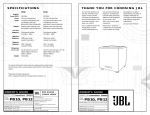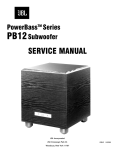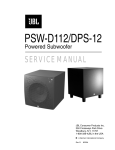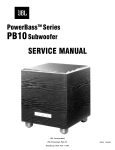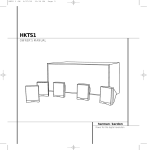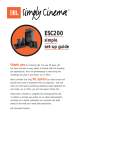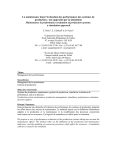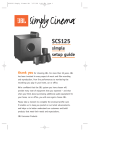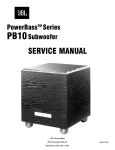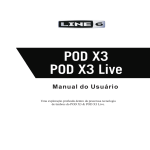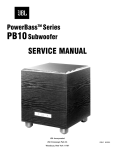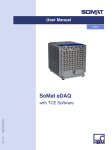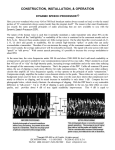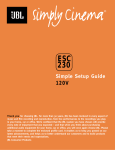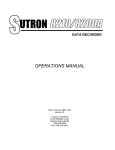Download PowerBass Series PB12 Subwoofer PRELIMINARY SERVICE MANUAL
Transcript
PowerBass Series PB12 Subwoofer PRELIMINARY SERVICE MANUAL JBL Incorporated, Inc. 250 Crossways Park Dr. Woodbury, New York 11797 - CONTENTS - BASIC SPECIFICATIONS ……….……………….…….……………..……………..2 DETAILED PB12 SPECIFICATIONS…………………….……….……..……………....3 CONNECTIONS…………………………………………………..……………..………..4 OPERATION………………………………….……………………………………..…….8 TROUBLESHOOTING…………………….…………….………………..….……..…….9 ELECTRICAL PARTS LIST ……………….…………..…………..……………….…10 MECHANICAL/PACKING PARTS LIST……………….……..……….…………….…15 PCB DRAWINGS……………….…………..……………….………..….………………16 SCHEMATICS ………..……………………..………………...…….………………..19 1 GENERAL SPECIFICATIONS PB12 Subwoofer Output Power 250 watts RMS Driver 12" Woofer Frequency Response 25Hz – to Low Pass Frequency setting Inputs Line Level (option: LFE); Speaker Level Outputs Speaker level fixed frequency 150Hz Low-Pass Frequency Variable from 50Hz – 150Hz High-Pass Frequency 150Hz when using Speaker Level Output Dimensions (H x W x D) 15 1/2" x 15" x 16" 394mm x 381mm x 406mm (with feet) 17 1/2" x 15" x 16" 445mm x 381mm x 406mm Weight 40 lb/18.2kg Refinements may be made on occasion to existing products without notice but will always meet or exceed original specifications unless otherwise stated. PowerBass is a registered trademark of JBL Incorporated. 2 JBL PB 12 250W Powered Sub Amp LINE VOLTAGE US 120vac/60Hz EU 230vac/50-60Hz Yes/No Yes Yes Hi/Lo Line 108-132 207-264 Nom. 120 230 Specification Unit QA Test Limits D 5.6 250 0.3 0.1 10 n/a Ohms Watts % % mV-DC n/a n/a 145 1 0.5 20 Nominal 1 input driven 22k filter 22k filter @ Speaker Outputs Damping factor >50 DF 35 Measured at amplifier board Measured at the speaker cable. 150 Watts @ THD < 0.1 % @ 50 Hz Input Sensitivity Input Frequency L&R LFE input Speaker/Hi Level Input 50 240 240 2.4 Hz mVrms mVrms Vrms 50 ±2dB ±2dB ±2dB Nominal Freq. To 150 Watts To 150 Watts To 150 Watts Single input driven Single input driven, LFE switch ON Single input driven Signal to Noise SNR-A-Weighted SNR-unweighted SNR rel. 1W-unweighted Residual Noise Floor 90 85 65 1 dBA dBr dBr mVrms 80 80 60 2 Residual Noise Floor 1.5 mVrms(max) Parameter Amp Section Type (Class AB, D, other) Load Impedance (speaker) Rated Output Power THD @ Rated Power THD @ 1 Watt DC Offset Input Impedance Line Input (L, R,LFE) Speaker/Hi Level Input Filters LP filter 4th order fixed Subsonic filter (HPF) 2nd Order LFE Low pass 2nd order HP speaker out connector Limiter THD at Max. Output Power Features Volume pot Taper (lin/log) HP Speaker out Phase switch LP Filter defeat switch 20K 4.7K 60-180 Fixed 200>LP<1K 200 100 n/a ohms ohms 2 n/a n/a Hz ± 10 Hz Hz Hz ± 10 ± 10 n/a Unit Vrms Vrms Notes Normal Operation Normal operation, MOMS required Conditions Notes Peak 145 Watts relative to rated power A-Weighting filter relative to rated power 22k filter relative to 1W Output 22k filter Volume @max, using RMS reading DMM/VOM (or A/P) BW=20 Khz. Volume @max, w/ A/P Swept Bandpass Measurement (Line freq.+ harmonics) (BW=20 Khz) Nominal Nominal 2nd order variable + 2nd order fix-24 db/Octave LFE input driven only Speaker input driven - 4 Ohms Speaker input driven - 8 Ohms functional Maximum Output Power Maximum THD as a result of limiting. functional functional functional functional A Taper Refer to Filter section -LOG YES 0-180 YES -deg Disables LP filter, intended for LFE Input Configuration Line In (L,R) & LFE Spkr/Hi Level In YES -- functional Dual RCA jack YES -- functional Binding post connector L&R Signal Sensing (ATO) Auto-Turn-On (yes/no) ATO Input test frequency ATO Level LFE Input ATO Level Speaker in YES 50 4 50 Hz mV mV functional functional functional functional Maximum acceptable level. Maximum acceptable level. ATO Turn-on time Auto Mute/ Turn-OFF Time Power on Delay time Transients/Pops ATO Transient Turn-on Transient Turn-off Transient Efficiency Efficiency Stand-by Input Power Power Cons. @ rated power Short Circuit Protection Thermal Protection DC Offset Protection Line Fuse Rating USA-Domestic (120v) EU (230v) " " " Amp connected and AC on, then functional input signal applied 15 T before muting, after signal removed 4 AC Power Applied 5 15 ms minutes 3 sec. 5 50 50 mV-peak mV-peak mV-peak n/a 2v-pp 2v-pp @ Speaker Outputs @ Speaker Outputs @ Speaker Outputs 65 24 234 % Watts Watts 64 26 240 @ nom. line voltage @ nom. line voltage 2 1 Amps Amps AC Line cycled from OFF to ON AC Line cycled from ON to OFF Nominal Line voltage 120 VAC functional Direct short at output functional DC present at Speaker Out leads YES YES YES Auto turn of time (T) must be 5 > T < 15 Minutes Type-T or Slo Blo-250 V Type-T or Slo Blo-250 V 150 Watts @ 5.6 Ohms nominal line voltage Amplifier should resume operation after short External fuse with UL/SEMKO rated holder 3 READ THIS! CAUTION RISK OF ELECTRIC SHOCK DO NOT OPEN CAUTION: To prevent electric shock, do not remove the grounding plug on the power cord, or use any plug or extension cord that does not have a grounding plug provided. Make certain that the AC outlet is properly grounded. Do not use an adapter plug with this product. The lightning flash with arrowhead symbol, within an equilateral triangle, is intended to alert the user to the presence of uninsulated “dangerous voltage” within the product’s enclosure that may be of sufficient magnitude to constitute a risk of electric shock to persons. The exclamation point within an equilateral triangle is intended to alert the user to the presence of important operating and maintenance (servicing) instructions in the literature accompanying the appliance. 1. Read Instructions. All the safety and operating instructions should be read before the product is operated. 2. Retain Instructions. The safety and operating instructions should be retained for future reference. 3. Heed Warnings. All warnings on the product and in the operating instructions should be adhered to. 4. Follow Instructions. All operating and use instructions should be followed. 5. Cleaning. Unplug this product from the wall outlet before cleaning. Do not use liquid cleaners or aerosol cleaners. Use a damp cloth for cleaning. 6. Attachments. Do not use attachments not recommended by the product manufacturer, as they may cause hazards. 7. Water and Moisture. Do not use this product near water – for example, near a bathtub, wash bowl, kitchen sink or laundry tub; in a wet basement; or near a swimming pool; and the like. 8. Accessories. Do not place this product on an unstable cart, stand, tripod, bracket, or table. The product may fall, causing serious injury to a child or adult, and serious damage to the product. Use only with a cart, stand, tripod, bracket, or table recommended by the manufacturer, or sold with the product. Any mounting of the product should follow the manufacturer’s instructions, and should use a mounting accessory recommended by the manufacturer. 9. A Product and Cart Combination Should Be Moved with Care. Quick stops, excessive force, and uneven surfaces may cause the product and cart combination to overturn. 10. Ventilation. Slots and openings in the cabinet are provided for ventilation and to ensure reliable operation of the product and to protect it from overheating, and these openings must not be blocked or covered. The openings should never be blocked by placing the product on a bed, sofa, rug, or other similar surface. This product should not be placed in a built-in installation such as a bookcase or rack unless proper ventilation is provided or the manufacturer’s instructions have been adhered to. 2 Important Safety Precautions! 11. Power Sources. This product should be operated only from the type of power source indicated on the marking label. If you are not sure of the type of power supply to your home, consult your product dealer or local power company. For products intended to operate from battery power, or other sources, refer to the operating instructions. 12. Grounding or Polarization. This product may be equipped with a polarized alternating-current line plug (a plug having one blade wider than the other). This plug will fit into the power outlet only one way. This is a safety feature. If you are unable to insert the plug fully into the outlet, try reversing the plug. If the plug should still fail to fit, contact your electrician to replace your obsolete outlet. Do not defeat the safety purpose of the polarized plug. 13. Power-Cord Protection. Power-supply cords should be routed so that they are not likely to be walked on or pinched by items placed upon or against them, paying particular attention to cords at plugs, convenience receptacles, and the point where they exit from the product. 14. Nonuse Periods. The power cord of the product should be unplugged from the outlet when left unused for long periods of time. 15. Outdoor Antenna Grounding. If an outside antenna or cable system is connected to the product, be sure the antenna or cable system is grounded so as to provide some protection against voltage surges and builtup static charges. Article 810 of the National Electrical Code, ANSI/NFPA 70, provides information with regard to proper grounding of the mast and supporting structure, grounding of the lead-in wire to an antenna discharge unit, size of grounding conductors, location of antenna-discharge unit, connection to grounding electrodes, and requirements for the grounding electrode. See Figure A. 16. Lightning. For added protection for this product during a lightning storm, or when it is left unattended and unused for long periods of time, unplug it from the wall outlet and disconnect the antenna or cable system. This will prevent damage to the product due to lightning and power-line surges. 17. Power Lines. An outside antenna system should not be located in the vicinity of overhead power lines or other electric light or power circuits, or where it can fall into such power lines or circuits. When installing an outside antenna system, extreme care should be taken to keep from touching such power lines or circuits, as contact with them might be fatal. 18. Overloading. Do not overload wall outlets, extension cords, or integral convenience receptacles, as this can result in a risk of fire or electric shock. 19. Object and Liquid Entry. Never push objects of any kind into this product through openings, as they may touch dangerous voltage points or short-out parts that could result in a fire or electric shock. Never spill liquid of any kind on the product. 20. Servicing. Do not attempt to service this product yourself, as opening or removing covers may expose you to dangerous voltage or other hazards. Refer all servicing to qualified service personnel. 21. Damage Requiring Service. Unplug this product from the wall outlet and refer servicing to qualified service personnel under the following conditions: a. The power-supply cord or the plug has been damaged; or b. Objects have fallen onto, or liquid has been spilled into, the product; or c. The product has been exposed to rain or water; or d. The product does not operate normally when following the operating instructions. Adjust only those controls that are covered by the operating instructions, as an improper adjustment of other controls may result in damage and will often require extensive work by a qualified technician to restore the product to its normal operation; or e. The product has been dropped or damaged in any way; or f. The product exhibits a distinct change in performance – this indicates a need for service. 22. Replacement Parts. When replacement parts are required, be sure the service technician has used replacement parts specified by the manufacturer or that have the same characteristics as the original part. Unauthorized substitutions may result in fire, electric shock or other hazards. 23. Safety Check. Upon completion of any service or repairs to this product, ask the service technician to perform safety checks to determine that the product is in proper operating condition. 24. Wall or Ceiling Mounting. The product should be mounted to a wall or ceiling only as recommended by the manufacturer. 25. Heat. The product should be situated away from heat sources such as radiators, heat registers, stoves, or other products (including amplifiers) that produce heat. Figure A. Example of Antenna Grounding as per National Electrical Code, ANSI/NFPA 70 Antenna Lead-In Wire Ground Clamp Antenna Discharge Unit (NEC Section 810-20) Grounding Conductors (NEC Section 810-21) Electric Service Equipment Ground Clamps Power Service Grounding Electrode System (NEC Art 250, Part H) Part No. JBLULB 10/99 SPEAKER PLACEMENT • As a general rule, bass response increases as a subwoofer is placed closer to a wall. Therefore, bass output is maximized when the subwoofer is placed in a corner. • It is also recommended that the subwoofer be positioned along the same wall as the front loudspeakers. Low-frequency sounds are normally omnidirectional, meaning the listener can’t tell where they are generated from. However, frequencies between 75Hz – 150Hz can be localized, especially at higher volume levels. Positioning your subwoofer as recommended will provide the most natural soundstage and imaging from your loudspeaker system. Remember that these are just guidelines. Since every listening room is different, JBL strongly recommends experimenting with the positioning of your subwoofer to obtain the most pleasing results in your room. One technique that can help you find the ideal subwoofer location is to temporarily place the subwoofer near the main listening location. Then move around the room and determine where you hear the most pleasing bass performance. This would then be the ideal location for the subwoofer. SPEAKER CONNECTION When we designed the PB10 and PB12 powered subwoofers, our goal was to offer the user the best possible performance combined with the most flexible and complete installation options. Please look over the following three examples to determine which description best matches your system and follow the corresponding hookup instructions. To use the binding-post speaker terminals with bare wire, unscrew the collar until the hole through the center Dolby* Pro Logic* (Non-Digital) – Speaker Level Use this installation method for Dolby Pro Logic applications (not Dolby Digital, DTS® or other digital processing), where the receiver/processor does not have a subwoofer output or a volume-controlled preamp (line-) level output: Connect your receiver or amplifier’s front left and right speaker terminals to the left and right terminals on the subwoofer that are marked “High Level In.” Connect the left and right terminals on the subwoofer that are marked “High Level Out” to the corresponding terminals on the post is visible under the collar. Insert the bare end of the wire through the hole in the post, then screw the collar back down until the connection is tight. The holes in the center of the collars are intended for banana-type connectors. Left Front + Right Front Center – + back of your front left and right speakers. + – – Subwoofer Connect your receiver or amplifier’s center, left and right surround-speaker terminals to the corresponding terminals on the back of your center, left and right surround speakers. L HIGH LEVEL IN + R – L HIGH LEVEL OUT` R Receiver Left Front + – Left Surround + – Left Surround + – Center + Right Front – + – Right Surround + – Right Surround + – 4 READ THIS! CAUTION RISK OF ELECTRIC SHOCK DO NOT OPEN CAUTION: To prevent electric shock, do not remove the grounding plug on the power cord, or use any plug or extension cord that does not have a grounding plug provided. Make certain that the AC outlet is properly grounded. Do not use an adapter plug with this product. The lightning flash with arrowhead symbol, within an equilateral triangle, is intended to alert the user to the presence of uninsulated “dangerous voltage” within the product’s enclosure that may be of sufficient magnitude to constitute a risk of electric shock to persons. The exclamation point within an equilateral triangle is intended to alert the user to the presence of important operating and maintenance (servicing) instructions in the literature accompanying the appliance. 1. Read Instructions. All the safety and operating instructions should be read before the product is operated. 2. Retain Instructions. The safety and operating instructions should be retained for future reference. 3. Heed Warnings. All warnings on the product and in the operating instructions should be adhered to. 4. Follow Instructions. All operating and use instructions should be followed. 5. Cleaning. Unplug this product from the wall outlet before cleaning. Do not use liquid cleaners or aerosol cleaners. Use a damp cloth for cleaning. 6. Attachments. Do not use attachments not recommended by the product manufacturer, as they may cause hazards. 7. Water and Moisture. Do not use this product near water – for example, near a bathtub, wash bowl, kitchen sink or laundry tub; in a wet basement; or near a swimming pool; and the like. 8. Accessories. Do not place this product on an unstable cart, stand, tripod, bracket, or table. The product may fall, causing serious injury to a child or adult, and serious damage to the product. Use only with a cart, stand, tripod, bracket, or table recommended by the manufacturer, or sold with the product. Any mounting of the product should follow the manufacturer’s instructions, and should use a mounting accessory recommended by the manufacturer. 9. A Product and Cart Combination Should Be Moved with Care. Quick stops, excessive force, and uneven surfaces may cause the product and cart combination to overturn. 10. Ventilation. Slots and openings in the cabinet are provided for ventilation and to ensure reliable operation of the product and to protect it from overheating, and these openings must not be blocked or covered. The openings should never be blocked by placing the product on a bed, sofa, rug, or other similar surface. This product should not be placed in a built-in installation such as a bookcase or rack unless proper ventilation is provided or the manufacturer’s instructions have been adhered to. 2 Important Safety Precautions! 11. Power Sources. This product should be operated only from the type of power source indicated on the marking label. If you are not sure of the type of power supply to your home, consult your product dealer or local power company. For products intended to operate from battery power, or other sources, refer to the operating instructions. 12. Grounding or Polarization. This product may be equipped with a polarized alternating-current line plug (a plug having one blade wider than the other). This plug will fit into the power outlet only one way. This is a safety feature. If you are unable to insert the plug fully into the outlet, try reversing the plug. If the plug should still fail to fit, contact your electrician to replace your obsolete outlet. Do not defeat the safety purpose of the polarized plug. 13. Power-Cord Protection. Power-supply cords should be routed so that they are not likely to be walked on or pinched by items placed upon or against them, paying particular attention to cords at plugs, convenience receptacles, and the point where they exit from the product. 14. Nonuse Periods. The power cord of the product should be unplugged from the outlet when left unused for long periods of time. 15. Outdoor Antenna Grounding. If an outside antenna or cable system is connected to the product, be sure the antenna or cable system is grounded so as to provide some protection against voltage surges and builtup static charges. Article 810 of the National Electrical Code, ANSI/NFPA 70, provides information with regard to proper grounding of the mast and supporting structure, grounding of the lead-in wire to an antenna discharge unit, size of grounding conductors, location of antenna-discharge unit, connection to grounding electrodes, and requirements for the grounding electrode. See Figure A. 16. Lightning. For added protection for this product during a lightning storm, or when it is left unattended and unused for long periods of time, unplug it from the wall outlet and disconnect the antenna or cable system. This will prevent damage to the product due to lightning and power-line surges. 17. Power Lines. An outside antenna system should not be located in the vicinity of overhead power lines or other electric light or power circuits, or where it can fall into such power lines or circuits. When installing an outside antenna system, extreme care should be taken to keep from touching such power lines or circuits, as contact with them might be fatal. 18. Overloading. Do not overload wall outlets, extension cords, or integral convenience receptacles, as this can result in a risk of fire or electric shock. 19. Object and Liquid Entry. Never push objects of any kind into this product through openings, as they may touch dangerous voltage points or short-out parts that could result in a fire or electric shock. Never spill liquid of any kind on the product. 20. Servicing. Do not attempt to service this product yourself, as opening or removing covers may expose you to dangerous voltage or other hazards. Refer all servicing to qualified service personnel. 21. Damage Requiring Service. Unplug this product from the wall outlet and refer servicing to qualified service personnel under the following conditions: a. The power-supply cord or the plug has been damaged; or b. Objects have fallen onto, or liquid has been spilled into, the product; or c. The product has been exposed to rain or water; or d. The product does not operate normally when following the operating instructions. Adjust only those controls that are covered by the operating instructions, as an improper adjustment of other controls may result in damage and will often require extensive work by a qualified technician to restore the product to its normal operation; or e. The product has been dropped or damaged in any way; or f. The product exhibits a distinct change in performance – this indicates a need for service. 22. Replacement Parts. When replacement parts are required, be sure the service technician has used replacement parts specified by the manufacturer or that have the same characteristics as the original part. Unauthorized substitutions may result in fire, electric shock or other hazards. 23. Safety Check. Upon completion of any service or repairs to this product, ask the service technician to perform safety checks to determine that the product is in proper operating condition. 24. Wall or Ceiling Mounting. The product should be mounted to a wall or ceiling only as recommended by the manufacturer. 25. Heat. The product should be situated away from heat sources such as radiators, heat registers, stoves, or other products (including amplifiers) that produce heat. Figure A. Example of Antenna Grounding as per National Electrical Code, ANSI/NFPA 70 Antenna Lead-In Wire Ground Clamp Antenna Discharge Unit (NEC Section 810-20) Grounding Conductors (NEC Section 810-21) Electric Service Equipment Ground Clamps Power Service Grounding Electrode System (NEC Art 250, Part H) Part No. JBLULB 10/99 SPEAKER PLACEMENT • As a general rule, bass response increases as a subwoofer is placed closer to a wall. Therefore, bass output is maximized when the subwoofer is placed in a corner. • It is also recommended that the subwoofer be positioned along the same wall as the front loudspeakers. Low-frequency sounds are normally omnidirectional, meaning the listener can’t tell where they are generated from. However, frequencies between 75Hz – 150Hz can be localized, especially at higher volume levels. Positioning your subwoofer as recommended will provide the most natural soundstage and imaging from your loudspeaker system. Remember that these are just guidelines. Since every listening room is different, JBL strongly recommends experimenting with the positioning of your subwoofer to obtain the most pleasing results in your room. One technique that can help you find the ideal subwoofer location is to temporarily place the subwoofer near the main listening location. Then move around the room and determine where you hear the most pleasing bass performance. This would then be the ideal location for the subwoofer. SPEAKER CONNECTION When we designed the PB10 and PB12 powered subwoofers, our goal was to offer the user the best possible performance combined with the most flexible and complete installation options. Please look over the following three examples to determine which description best matches your system and follow the corresponding hookup instructions. To use the binding-post speaker terminals with bare wire, unscrew the collar until the hole through the center Dolby* Pro Logic* (Non-Digital) – Speaker Level Use this installation method for Dolby Pro Logic applications (not Dolby Digital, DTS® or other digital processing), where the receiver/processor does not have a subwoofer output or a volume-controlled preamp (line-) level output: Connect your receiver or amplifier’s front left and right speaker terminals to the left and right terminals on the subwoofer that are marked “High Level In.” Connect the left and right terminals on the subwoofer that are marked “High Level Out” to the corresponding terminals on the post is visible under the collar. Insert the bare end of the wire through the hole in the post, then screw the collar back down until the connection is tight. The holes in the center of the collars are intended for banana-type connectors. Left Front + Right Front Center – + back of your front left and right speakers. + – – Subwoofer Connect your receiver or amplifier’s center, left and right surround-speaker terminals to the corresponding terminals on the back of your center, left and right surround speakers. L HIGH LEVEL IN + R – L HIGH LEVEL OUT` R Receiver Left Front + – Left Surround + Right Front – + – Right Surround – Left Surround + Center + + – Right Surround – + 5 – Dolby Pro Logic (Non-Digital) – Line Level Use this installation method for Dolby Pro Logic applications (not Dolby Digital, DTS or other digital processing), where the receiver/processor is equipped with a subwoofer output or a volume-controlled preamp (line-) level output: Use RCA-type patch cords to connect the line-level subwoofer outputs on your receiver or amplifier to the line-level inputs on the subwoofer. IMPORTANT: Make sure that the LFE toggle switch on the subwoofer is in the “Normal” position. Do not Dolby Digital or DTS (or Other Digital Surround Mode) Connection use the “LFE” position with Dolby Pro Logic-only processors. Note: If your receiver or amplifier only has one subwoofer output jack, then you may connect the subwoofer output on your receiver/preamplifier to either the left or right line-level input on the subwoofer. It makes no difference which jack you choose. Make sure your receiver or processor is configured correctly: Make sure that the subwoofer is configured as “On.” Note for advanced users: If your receiver/processor has a built-in low-pass crossover filter for the subwoofer output, then the LFE switch should be set to the “LFE” position to bypass the subwoofer’s internal crossover. Use this installation method for Dolby Digital, DTS or other digital surround processors: IMPORTANT: Make sure that the LFE toggle switch on the subwoofer is in the “LFE” position. Use the line-level input jacks for the LowFrequency Effects channel. Connect these jacks to the LFE output or subwoofer output on your receiver or amplifier. Note: If your receiver or amplifier only has one subwoofer output jack, Connect each speaker to the corresponding speaker terminals on your receiver or amplifier. LEVEL Make sure that you have configured your surroundsound processor for “Subwoofer On” or “LFE On.” The front left, front right, LEVEL LFE PHASE NORMAL 0º LFE PHASE 180º NORMAL 0º 180º CROSSOVER FREQUENCY 150Hz 50Hz R L Subwoofer Output/LFE R LINE LEVEL IN 150Hz 50Hz RECEIVER/PREAMPLIFIER Subwoofer Out L R LINE LEVEL IN For LFE use L or R + Max Min CROSSOVER FREQUENCY L center and rear speakers should be set to “Small” or “Large” depending on their size and frequency response. Consult your receiver’s or processor’s owner’s manual. Connect each speaker to the corresponding speaker terminals on your receiver or amplifier. Max Min RECEIVER then you may connect the subwoofer output on your receiver/preamplifier to either the left or right line-level input on the subwoofer. It makes no difference which jack you choose. – For LFE use L or R L L HIGH LEVEL IN HIGH LEVEL IN R R + – L L HIGH LEVEL OUT HIGH LEVEL OUT R R 6 5 Dolby Pro Logic (Non-Digital) – Line Level Use this installation method for Dolby Pro Logic applications (not Dolby Digital, DTS or other digital processing), where the receiver/processor is equipped with a subwoofer output or a volume-controlled preamp (line-) level output: Use RCA-type patch cords to connect the line-level subwoofer outputs on your receiver or amplifier to the line-level inputs on the subwoofer. IMPORTANT: Make sure that the LFE toggle switch on the subwoofer is in the “Normal” position. Do not Dolby Digital or DTS (or Other Digital Surround Mode) Connection use the “LFE” position with Dolby Pro Logic-only processors. Note: If your receiver or amplifier only has one subwoofer output jack, then you may connect the subwoofer output on your receiver/preamplifier to either the left or right line-level input on the subwoofer. It makes no difference which jack you choose. Connect each speaker to the corresponding speaker terminals on your receiver or amplifier. Make sure your receiver or processor is configured correctly: Make sure that the subwoofer is configured as “On.” Note for advanced users: If your receiver/processor has a built-in low-pass crossover filter for the subwoofer output, then the LFE switch should be set to the “LFE” position to bypass the subwoofer’s internal crossover. Use this installation method for Dolby Digital, DTS or other digital surround processors: IMPORTANT: Make sure that the LFE toggle switch on the subwoofer is in the “LFE” position. Use the line-level input jacks for the LowFrequency Effects channel. Connect these jacks to the LFE output or subwoofer output on your receiver or amplifier. Note: If your receiver or amplifier only has one subwoofer output jack, LEVEL Make sure that you have configured your surroundsound processor for “Subwoofer On” or “LFE On.” The front left, front right, LEVEL LFE PHASE NORMAL 0º LFE PHASE 180º 150Hz Subwoofer Out R L R LINE LEVEL IN 0º 180º 150Hz 50Hz RECEIVER/PREAMPLIFIER Subwoofer Output/LFE L R LINE LEVEL IN For LFE use L or R 4 NORMAL CROSSOVER FREQUENCY 50Hz + Max Min CROSSOVER FREQUENCY L center and rear speakers should be set to “Small” or “Large” depending on their size and frequency response. Consult your receiver’s or processor’s owner’s manual. Connect each speaker to the corresponding speaker terminals on your receiver or amplifier. Max Min RECEIVER then you may connect the subwoofer output on your receiver/preamplifier to either the left or right line-level input on the subwoofer. It makes no difference which jack you choose. – For LFE use L or R L L HIGH LEVEL IN HIGH LEVEL IN R R + – L L HIGH LEVEL OUT HIGH LEVEL OUT R R 7 Phase Control O P E R AT I O N Power When the unit is plugged in and (for the PB12 only) the power switch is on and no signal is received, the LEDs on the front of the unit will turn red. When a signal is present, the LEDs will turn green. Note: It will take several minutes for the LEDs to turn from green to red after the input signal to the subwoofer is removed. Due to JBL’s unique, high-output, highefficiency amplifier design, power consumption is minimal when the subwoofer is not receiving a signal. Of course, the PB12 subwoofer can be turned off, whenever desired. The PB10 must be unplugged if you do not wish to leave it in auto (standby) mode. The Phase Control determines whether the subwoofer’s piston-like action moves in and out in phase with the main speakers or opposite the main speakers. There is no correct or incorrect setting. Proper phase adjustment depends on several variables such as subwoofer placement and listener position. Adjust the phase switch to maximize Level Control The subwoofer Level Control adjusts the volume of the subwoofer relative to the rest of the system. Proper level adjustment depends on several variables such as room size, subwoofer placement, type of main speakers and listener position. Adjust the subwoofer level so that the volume of the bass information is pleasing to you. If you used the high-level (speaker) inputs and there is no sound from any of the speakers: LEVEL • Check that receiver/amplifier is on and a source is playing. • Check that powered subwoofer is plugged into an active electrical outlet and is switched on. • Check all wires and connections between receiver/amplifier and speakers. Make sure all wires are connected. Make sure none of the speaker wires are frayed, cut or punctured. • Review proper operation of your receiver/amplifier. LEVEL Max Min LFE PHASE Max Min NORMAL 0º LFE PHASE 180º CROSSOVER FREQUENCY NORMAL 0º 180º CROSSOVER FREQUENCY 150Hz 50Hz 150Hz 50Hz PowerBass PB10 PowerBass PB12 L L R LINE LEVEL IN R LINE LEVEL IN For LFE use L or R For LFE use L or R L L HIGH LEVEL IN HIGH LEVEL IN R + – R + – L L HIGH LEVEL OUT HIGH LEVEL OUT R R 120V 60Hz, 160W ON OFF 120V 60Hz, 160W POWER PowerBass PB10 Remember, every system, room and listener is different. There are no right or wrong settings; this switch offers the added flexibility to adjust your subwoofer for optimum performance for your specific listening conditions without having to move your speakers. If at some time in the future you happen to rearrange your listening room and move your speakers, you should experiment with the phase switch in both positions, and leave it in the position that maximizes bass performance. TROUBLESHOOTING Crossover Adjustments The Crossover Frequency Control determines the highest frequency at which the subwoofer reproduces sounds. If your main speakers can comfortably reproduce some low-frequency sounds, set this control to a lower frequency setting, between 50Hz – 100Hz. This will concentrate the subwoofer’s efforts on the ultradeep bass sounds required by today’s films and music. If you are using smaller bookshelf speakers that do not extend to the lower bass frequencies, set the low-pass crossover control to a higher setting, between 120Hz – 150Hz. This control is not used when the LFE switch is in the “LFE” position. bass output at the listening position. If there is low (or no) bass output: • Make sure the connections to the left and right “Speaker Inputs” have the correct polarity (+ and –). • Make sure that the subwoofer is plugged into an active electrical outlet and (PB12 only) switched on. • Adjust the crossover point. • Flip the Phase Control switch to the opposite position. • If you are using a Dolby Digital/DTS receiver or processor, make sure that the subwoofer adjustments on the receiver/processor are set up correctly. • Slowly turn the Level Control clockwise until you begin to hear the desired amount of bass. If you used the line-level inputs and there is no sound from the subwoofer: • Check that receiver/amplifier is on and a source is playing. • Check that powered subwoofer is plugged into an active electrical outlet and is switched on. • Check all wires and connections between receiver/ amplifier and subwoofer. Make sure all wires are connected. Make sure none of the wires are frayed, cut or punctured. • Review proper operation of your receiver/amplifier. • Slowly turn the Level Control clockwise until you begin to hear the desired amount of bass. • Make sure that you have configured your receiver/ processor so that the subwoofer/LFE output is on. PowerBass PB12 CAUTION CAUTION RISK OF ELECTRIC SHOCK DO NOT OPEN RISK OF ELECTRIC SHOCK DO NOT OPEN 8 7 Phase Control O P E R AT I O N Power When the unit is plugged in and (for the PB12 only) the power switch is on and no signal is received, the LEDs on the front of the unit will turn red. When a signal is present, the LEDs will turn green. Note: It will take several minutes for the LEDs to turn from green to red after the input signal to the subwoofer is removed. Due to JBL’s unique, high-output, highefficiency amplifier design, power consumption is minimal when the subwoofer is not receiving a signal. Of course, the PB12 subwoofer can be turned off, whenever desired. The PB10 must be unplugged if you do not wish to leave it in auto (standby) mode. Level Control The subwoofer Level Control adjusts the volume of the subwoofer relative to the rest of the system. Proper level adjustment depends on several variables such as room size, subwoofer placement, type of main speakers and listener position. Adjust the subwoofer level so that the volume of the bass information is pleasing to you. If you used the high-level (speaker) inputs and there is no sound from any of the speakers: LEVEL LEVEL Max Min LFE PHASE LFE PHASE 180º CROSSOVER FREQUENCY NORMAL 0º 180º CROSSOVER FREQUENCY 150Hz 50Hz 150Hz 50Hz PowerBass PB10 PowerBass PB12 L L R LINE LEVEL IN R LINE LEVEL IN For LFE use L or R For LFE use L or R L L HIGH LEVEL IN HIGH LEVEL IN R + – R + – L L HIGH LEVEL OUT HIGH LEVEL OUT R R 120V 60Hz, 160W ON OFF 120V 60Hz, 160W POWER PowerBass PB10 6 Max Min NORMAL 0º bass output at the listening position. Remember, every system, room and listener is different. There are no right or wrong settings; this switch offers the added flexibility to adjust your subwoofer for optimum performance for your specific listening conditions without having to move your speakers. If at some time in the future you happen to rearrange your listening room and move your speakers, you should experiment with the phase switch in both positions, and leave it in the position that maximizes bass performance. TROUBLESHOOTING Crossover Adjustments The Crossover Frequency Control determines the highest frequency at which the subwoofer reproduces sounds. If your main speakers can comfortably reproduce some low-frequency sounds, set this control to a lower frequency setting, between 50Hz – 100Hz. This will concentrate the subwoofer’s efforts on the ultradeep bass sounds required by today’s films and music. If you are using smaller bookshelf speakers that do not extend to the lower bass frequencies, set the low-pass crossover control to a higher setting, between 120Hz – 150Hz. This control is not used when the LFE switch is in the “LFE” position. The Phase Control determines whether the subwoofer’s piston-like action moves in and out in phase with the main speakers or opposite the main speakers. There is no correct or incorrect setting. Proper phase adjustment depends on several variables such as subwoofer placement and listener position. Adjust the phase switch to maximize PowerBass PB12 CAUTION CAUTION RISK OF ELECTRIC SHOCK DO NOT OPEN RISK OF ELECTRIC SHOCK DO NOT OPEN • Check that receiver/amplifier is on and a source is playing. • Check that powered subwoofer is plugged into an active electrical outlet and is switched on. • Check all wires and connections between receiver/amplifier and speakers. Make sure all wires are connected. Make sure none of the speaker wires are frayed, cut or punctured. • Review proper operation of your receiver/amplifier. If there is low (or no) bass output: • Make sure the connections to the left and right “Speaker Inputs” have the correct polarity (+ and –). • Make sure that the subwoofer is plugged into an active electrical outlet and (PB12 only) switched on. • Adjust the crossover point. • Flip the Phase Control switch to the opposite position. • If you are using a Dolby Digital/DTS receiver or processor, make sure that the subwoofer adjustments on the receiver/processor are set up correctly. • Slowly turn the Level Control clockwise until you begin to hear the desired amount of bass. If you used the line-level inputs and there is no sound from the subwoofer: • Check that receiver/amplifier is on and a source is playing. • Check that powered subwoofer is plugged into an active electrical outlet and is switched on. • Check all wires and connections between receiver/ amplifier and subwoofer. Make sure all wires are connected. Make sure none of the wires are frayed, cut or punctured. • Review proper operation of your receiver/amplifier. • Slowly turn the Level Control clockwise until you begin to hear the desired amount of bass. • Make sure that you have configured your receiver/ processor so that the subwoofer/LFE output is on. 9 7 Electrical Parts List - PB12 PB12 POWERAMP PCB Version 6.3. Part# Designator Description 50100 BR RECT RS604 6AMP Bridge rectifier 50105 D1 1N4744A 15V 1w Zener 50112 D10 1N5242B 12V .5w Zener 50104 D11 1N4148 50112 D12 1N5242B 50104 D13 1N4148 Sig Diode 50104 D14 1N4148 Sig Diode 50105 D2 1N4744A 15V 1w Zener 50114 D3 1N5265B 62V .5w Zener 50104 D4 1N4148 50113 D5 1N4735A 6.2V 1W 50103 D6 1N5234B 6V .5w Zener 50104 D7 1N4148 50104 D8 1N4148 60157 Q1 2N5457 25V N-chnl FET 60155 Q10 2N5401 120V PNP 600mA 60155 Q11 2N5401 120V PNP 600mA 60156 Q12 2N4401 40V NPN 600mA 60102 U1 TLO64 30710 C1 2200uF 100V 30718 C10 4u7F 100V 30523 C11 330nF 100V 30710 C2 2200uF 100V 30532 C20 220nF 250V metallized polyester 30502 C21 100nF 50V mono ceramic 30502 C22 100nF 50V mono ceramic 30527 C24 330nF 50V mono ceramic C25 NOT USED 30508 C26 10nF 50V mono ceramic 30513 C27 3n3F 50V mono ceramic 30502 C3 100nF 50V mono ceramic Sig Diode 12V .5w Zener Sig Diode Sig Diode Sig Diode Quad OpAmp Capacitors +80 / -20 Electrolytic 105C BP/NP Electr DF<.1 mono ceramic +80 / -20 Electrolytic 105C 30711 C32 22uF 35V +80/-20 Electrolytic 30715 C40 10uF 16V +80/-20 Electrolytic 30716 C41 1uF 16V +80/-20 Electrolytic 30717 C42 100uF 16V +80/-20 Electrolytic 30502 C6 100nF 50V mono ceramic 30521 C7A 100nF 250V ceramic/film 30521 C7B 100nF 250V ceramic/film CW NOT USED CZ 100nF 100V ceramic/film 30505 10 Part# Designator Description Resistors R100 NOT USED 40105 R10A 0.1R .5W metal 40105 R10B 0.1R .5W metal 40105 R10C 0.1R .5W metal 40420 R11 1k .25W carbon 40420 R12 1k .25W carbon 40417 R13 47k .25W carbon 40718 R14 3k3 .25W carbon R15 NOT USED 40735 R1A 7k5 2W metal 40735 R1B 7k5 2W metal 40735 R1C 7k5 2W metal 40405 R21 4K7 .25W carbon 40736 R22 42K2 .25W metal 40737 R23 187k .25W metal R24 NOT USED R25 NOT USED 40722 R26 6k8 .25W carbon 40738 R27 10k 2W metal 40739 R28 1k2 0.25W carbon 40739 R29 1k2 0.25W carbon 40735 R2A 7k5 2W metal 40735 R2B 7k5 2W metal 40735 R2C 7k5 2W metal 40703 R3 8M2 .25W carbon 40738 R30 10k 2W metal 40417 R31 47k .25W carbon 40417 R32 47k .25W carbon 40427 R33 23k7 .25W metal 40403 R34 10k .25W metal 40740 R4 33k 1W metal 40420 R40 1k .25W carbon 40701 R41 1000k .25W carbon 40741 R42 22k .5W metal 40701 R43 1000k .25W carbon 40406 R44 100k .25W carbon 40415 R45 470K .25W carbon 40701 R46 1000k .25W carbon 40409 R47 10k .25W carbon 40409 R48 10k .25W carbon 40726 R49 15k .25W carbon 40732 R5 56k2 .25W metal 40727 R50 2k2 .25W carbon 40111 R6 47R .25W carbon 40738 R7A 10k 2W metal 11 Part# Designator Description 40738 R7B 10k 2W metal 40738 R7C 10k 2W metal 40738 R8A 10k 2W metal 40738 R8B 10k 2W metal R9 NOT USED Miscellaneous 80121 L1 220uH 5 Amp Gapped Ecore choke 80122 L2 8u5H 5 Amp ferrite bead 80122 L3 8u5H 5 Amp ferrite bead 80122 L4 8u5H 5 Amp ferrite bead 80100 CMC 2m2H 5 Amp choke 60302 MODULE S64AMI 108326 Led Harness With two LED's,Molex Glued plug into cabinet 80116 Transformer MCI4632 70151 Switch SW SPST 70322 LED socket PCB mount LED socket 80117 3AG FUSE 2A SloBlo T type 70324 0.187" PCB Tabs 7 70323 PCB Fuse Holders 2 70325 PB12 faceplate PB12 faceplate 80105 Power cord Power cord 70305 Strain relief Strain relief 100VA 4632 transformer Power Switch PB12 PREAMP PCB Version #6.3 Part# Designator Description 60102 U1 TLO 64 OP amp 60100 U2 LM324 OP amp Capacitors Film Caps may be used in any position EXCEPT C1,C2 30707 C1 200uF 50V BP Electrolytic 30504 C10 100nF 50V mono ceramic 30504 C11 100nF 50V mono ceramic 30504 C12 100nF 50V mono ceramic 30504 C13 100nF 50V mono ceramic 30530 C16 100nF 50V mono ceramic 30531 C17 150nF 50V mono ceramic 30100 C18 330pF 50V mono ceramic 30100 C19 330pF 50V mono ceramic 30707 C2 200uF 50V BP Electrolytic 30502 C20 100nF 50V mono ceramic Semiconductors 12 Part# Designator Description 30502 C21 100nF 50V mono ceramic 30502 C22 100nF 50V mono ceramic 30502 C23 100nF 50V mono ceramic 30101 C3 220pF 50V mono ceramic C30 NOT USED 30101 C4 220pF 50V mono ceramic 30101 C5 220pF 50V mono ceramic 30101 C6 220p 50V mono ceramic C7 0r C8 0r C9 1k .25W Metal Resistor 40405 R1 4k7 .25W carbon 40409 R10 10k .25W carbon 40731 R11 59k .25W carbon 40504 R12 45k3 .25W metal 40412 R13 33k2 .25W metal 40709 R14 68k1 .25W metal R15 NOT USED R16 NOT USED 40730 Resistors 40732 R17 56k2 .25W metal 40722 R18 6k8 .25W carbon 40722 R19 6k8 .25W carbon 40405 R2 4k7 .25W carbon 40722 R20 6k8 .25W carbon R21 0r R22 6k8 .25W carbon R23 0r 40722 40109 R24 604r .25W metal 40412 R25 33k2 .25W metal 40405 R26 4k7 .25W metal 40109 R27 604r .25W metal 40412 R28 33k2 .25W metal 40406 R3 100k .25W carbon 40403 R30 10k .25W metal 40733 R33 12k1 .25W metal 40734 R34 120k .25W metal 40451 R35 137k .25W metal 40406 R4 100k .25W carbon 40406 R5 100k .25W carbon 40406 R6 100k .25W carbon 40717 R8 2k7 .25W carbon 40717 R9 2k7 .25W carbon 13 Miscellaneous 108320 RCA CONNECTOR 108116 HI LEVEL I/O Binding Post OUT DUAL RCA-yellow Binding Post 108116 HI LEVEL I/O Binding Post IN Binding Post 40402 LEVEL 5k POT Log (A) Pot 40707 Crossover CONTROL 20k POT Lin (B) Pot. 70150 LFE switch SW SPDT mini-Toggle 70150 Phase Switch SW SPDT mini-Toggle 14 PB12 MECHANICAL & PACKING PARTS LIST Part# Description 203500 12” Woofer 203410 Foot 203520 Outer Carton 203430 Owner’s manual 120V 203550 Amplifier complete 15 Vers63.gbl (Board layer 1) Scale=1.20 Wed May 17 08:26:14 2000 16 Vers63.gtl (Board layer 1) Scale=1.20 Wed May 17 08:36:44 2000 17 Vers63.gto (Board layer 1) Scale=1.36 Wed May 17 08:38:34 2000 18 1 2 4 3 R27 R11 604r D R In C18 330pF C19 330pF 6 5 GND U1 3 2 1 LEVEL 2 1 7 U2 5 C7 Phase Switch R13 1 U1 TLO64 R17 R15 NOT USED 137k 2 3 1k 0r R35 33k2 C9 C8 0r NOT USED R24 RCA CONNECTOR NOT USED 6 45k3 3 3rd Order Hi-Pass D R12 2 3 R25 33k2 68k1 SW SPDT 1 220p 7 5k POT REMOTE Pot C6 59k R28 33k2 L In R16 R14 DUAL RCA 56k2 604r R10 B-POST HiLev I/O 10k 200uF C 2nd Order LO-PASS R1 C1 4k7 R R C3 2nd Order Hi-Pass 220pF +15V R6 10 R5 9 L L OUT C2 4k7 C17 C4 100k R8 2k7 150nF C20 C21 220pF C16 U2 100nF 13 1 R19 20k POT 5 6k8 4 +15V C23 R34 220pF 2 LM324 100nF C22 12 100nF 14 U1 6 LO PASS CONTROL 2 120k 100nF C 3 -15V 3 C5 1 6k8 2 R9 2k7 IN 200uF 12k1 C10 20k POT R18 -15V R3 R2 R33 8 U1 R4 LO PASS CONTROL 1 C11 100nF 100nF 100nF R20 7 C12 9 From PwrAmp 1 2 From PwrAmp NOT USED NOT USED 100nF 6k8 1 13 2 12 14 3 GAIN STAGE R26 Un-designated Connector 4k7 To Pin 11 U1/U2 C30 NOT USED LoPass Defeat Sw. +15V R30 1 2 3 4 5 6 10k 9 NOT USED LED1 LO PASS CONTROL 4 1 2 SW SPDT U2 R22 Led Harness B 0r R21 8 11 R23 0r 12 8 U2 10 -15V 10 C13 To Pin 14 U1/U2 mute GND GND SIG -15V NOT USED 100nF NOT USED A Title A B12 PREAMP (6.3 pcb) Size Number Revision Tabloid Date: File: 1 +15V To/From PWRAMP LED 2 NOT USED 2nd Order LO-PASS NOT USED B LO PASS CONTROL 3 6k8 2 3 5 20-Apr-2000 Sheet1 of 1 T:\PB12 sch Folder\..\PB12 preamp Rev5.sch Drawn By: MS/LL 4 1 2 3 4 5 6 7 8 10 9 LED1/2 Preamp LED1/2 Preamp R46 F 1000k R45 SIGNAL LED & AUTO MUTE 470K R100 NOT USED To/From PREAMP Un-designated Connector E +15V mute GND GND SIG -15V 4 TLO64 3 U1 2 C40 6 C42 1k 1000k 1000k 100uF D12 1N5242B 11 R42 R44 100k 22k D13 2 1 1 2 MOLEX 2 1N4148 R47 10k 1N5242B D10 R43 R41 On Harness 7 U1 TLO64 D11 1N4148 1uF V+ LED F 4 5 2k2 R40 10uF -15 1N4148 D14 R50 1 11 To U1 Pin 11 +15 6 5 4 3 2 1 C41 Not Connected R49 15k Q1 MOLEX 2 R48 10k On Harness On Harness 2 Clr LED 2 Clr LED C24 To U1 Pin 4 NOT USED E 2N5457 330nF R21 4K7 C25 R7A NOT USED R22 10k R7B 10k R7C 10k 42K2 R23 12 13 100nF 14 U1 11 1N5234B 1N4148 D7 6k8 R1A 7k5 R1B 7k5 R1C 7k5 R29 1k2 R31 47k 1N4148 R3 SP Neg 8u5H 1N4148 10k C26 10nF 9 U1 SP Pos 8u5H NOT USED 22uF C21 100nF C27 3n3F D1 C22 100nF NOT USED FR C NOT USED R5 56k2 GND B MODULE R8A 10k R2B 7k5 R2C 7k5 MCI4632 On Faceplate CMC V+ R2A 7k5 C7A On Faceplate AC Feed C7B 2m2H 2A SloBlo SW SPST AC Return 100nF RS604 R8B 10k 3AG FUSE 100nF VBR RECT Title A B12 PwrAmp (6.0 PCB) C1 C2 2200uF Size 2200uF 3 CW -15V 1N4744A A 8u5H R15 I/P D2 2 220uH 100nF R9 B 1 L3 L1 S/D 10k TLO64 11 CZ 100nF 330nF VL2 C32 R34 D R10C 0.1R C11 C10 4u7F 1N4744A 23k7 R10B 0.1R +15V 8 Q12 2N4401 R11 O/P C3 4 2N5401 1k 8M2 47k R33 R10A 0.1R 220nF R32 10 3k3 L4 D4 R4 33k R30 D8 R14 47k V+ D3 UVLO 2N5401 C20 1N5265B R28 1k2 NOT USED Q10 R13 Q11 1k +6V R27 10k NOT USED R24 C S64 R12 R26 NOT USED R6 47R D5 1N4735A 1 2 3 TLO64 R25 D6 CONNECTOR AV SW 187k 4 D SHORT CIRCUIT PROTECT C6 4 Number 1 D 5 6 7 Date: File: 8 Revision 5 20-Apr-2000 Sheet 1 of 1 T:\PB12 sch Folder\..\PB12 PwrAmp Rev5.sch Drawn By: MA / LL 9 10





















